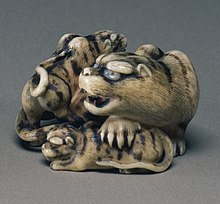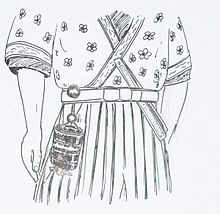Netsuke
These containers may have been pouches or small woven baskets, but the most popular were crafted boxes (inrō) held shut by ojime, sliding beads on cords.This effect is particularly pronounced in netsuke, owing to long periods of isolation imposed both by geography and internal politics and limited avenues of self-expression for Japanese citizens due to custom and law.[9][10][11] As a result, netsuke display every aspect of Japanese culture, including its rich folklore and religion, crafts, trades, and professions, all types of people and creatures, both real and imagined, and every kind of object.As in other aspects of Japanese culture, the subjects portrayed by netsuke trend, over the long term, away from an initial emphasis on motifs of Chinese derivation toward a focus on objects of more strictly national interest.[22][23] The Tokyo National Museum has a small exhibition room dedicated to displaying 50 of the 500 contemporary netsuke works collected by the Prince and Princess Takamado.





The Hare with Amber EyesEdo periodkosodekimonoMeiji periodAmerican EnglishBritish EnglishhakamareliefmanjūmammothBoxwoodhardwoodsHippopotamusRhinocerosporcelainLacquerHornbill ivoryhelmeted hornbillblack coralligniteTertiary AgeAobayamaSendaiWalrusBaleensperm whalescrimshawtigersTagua nutivory palmPhytelephas aequatorialisWalnutBambooSeven Lucky GodsshungaKirishitanChristFukurokujuBentenNagoyaTametakaMuseum of Far Eastern Antiquities, StockholmMasanaoSeiyōdō TomiharuMetropolitan Museum of ArtLos Angeles County Museum of ArtAsian Art Museum of San FranciscoToledo Museum of ArtBritish MuseumVictoria and Albert MuseumsamuraiTokyo National MuseumPrincePrincess TakamadoEdmund de WaalEphrussi familyHolocaustDownton AbbeyBob's BurgersMacGuffinDaruma dollKinchakuChatelaineReticule (handbag)YatateJapanese handicraftsGothic boxwood miniatureOkimonoHeibonshaVictoria & Albert MuseumKarl-Ludwig Kley
